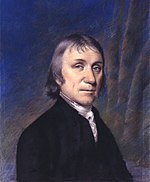Portal:Yorkshire
The Yorkshire Portal
Yorkshire (/ˈjɔːrkʃər, -ʃɪər/ YORK-shər, -sheer) is an area of Northern England which was historically a county. Despite no longer being used for administration, Yorkshire retains a strong regional identity. The county was named after its original county town, the city of York.
The south-west of Yorkshire is densely populated, and includes the cities of Leeds, Sheffield, Bradford, and Wakefield. The north and east of the county are more sparsely populated, however the north east includes the southern part of the Teesside conurbation, and the port city of Kingston upon Hull is located in the south-east. York is located near the centre of the county. Yorkshire has a coastline to the North Sea to the east. The North York Moors occupy the north east of the county, and the centre contains the Vale of Mowbray in the north and the Vale of York in the south. The west contains part of the Pennines, which form the Yorkshire Dales in the north-west. (Full article...)
Selected article

The LNER Class A3 Pacific steam locomotive No. 4472 Flying Scotsman (originally No. 1472) was built in 1923 for the London and North Eastern Railway (LNER) at Doncaster Works to a design of H.N. Gresley. It was employed on long-distance express trains on the LNER and its successors, British Railways Eastern and North-Eastern Regions, notably on the 10am London to Edinburgh Flying Scotsman train service after which it was named. Flying Scotsman is regarded as the world's most famous steam locomotive.
The locomotive is notable for having set two world records for steam traction; becoming the first steam locomotive to be officially authenticated at reaching 100 miles per hour (160.9 km/h) on 30 November 1934, and then setting a record for the longest non-stop run by a steam locomotive when it ran 422 miles (679 km) on 8 August 1989.
Retired from regular service in 1963 after covering 2,076,000 miles (3,341,000 km), Flying Scotsman gained considerable fame in preservation under the ownership of Alan Pegler, William McAlpine, Tony Marchington and finally the National Railway Museum. As well as hauling enthusiast specials in the United Kingdom, the locomotive toured extensively in the United States and Australia. (read more . . . )
Selected image

Credit: Paolo Margari
Park Hill is a council housing estate in Sheffield, South Yorkshire, the complex was Grade II* listed in 1998 making it the largest listed building in Europe. (read more . . . )
Selected biography

During his lifetime, Priestley's considerable scientific reputation rested on his invention of soda water, his writings on electricity, and his discovery of several "airs" (gases), the most famous being what Priestley dubbed "dephlogisticated air" (oxygen). However, Priestley's determination to reject what would become the chemical revolution and to cling to phlogiston theory eventually left him isolated within the scientific community.
Priestley's science was integral to his theology, and he consistently tried to fuse Enlightenment rationalism with Christian theism. In his metaphysical texts, Priestley attempted to combine theism, materialism, and determinism, a project that has been called "audacious and original". He believed that a proper understanding of the natural world would promote human progress and eventually bring about the Christian Millennium. Priestley, who strongly believed in the free and open exchange of ideas, advocated toleration and equal rights for religious Dissenters, which also led him to help found Unitarianism. (read more . . . )
Selected list -

Selected Did You Know . . .

- ... that Fountains Fell, (pictured), a mountain in the Yorkshire Dales, England, is named after Fountains Abbey whose monks grazed sheep there in the 13th century?
- ...that the Rotunda Museum houses one of the foremost collections of Jurassic geology on the Yorkshire Coast?
- ... that All Saints Church, Helmsley, contains two chapels dedicated to different saints?
- ...that an estimated 20 people died after eating peppermint humbugs that were accidentally made with arsenic in the 1858 Bradford sweets poisoning?
General images -
Subcategories
Selected panorama

Topics
Related portals
WikiProjects
Things you can do
Associated Wikimedia
The following Wikimedia Foundation sister projects provide more on this subject:
-
Commons
Free media repository -
Wikibooks
Free textbooks and manuals -
Wikidata
Free knowledge base -
Wikinews
Free-content news -
Wikiquote
Collection of quotations -
Wikisource
Free-content library -
Wikiversity
Free learning tools -
Wikivoyage
Free travel guide -
Wiktionary
Dictionary and thesaurus



















































